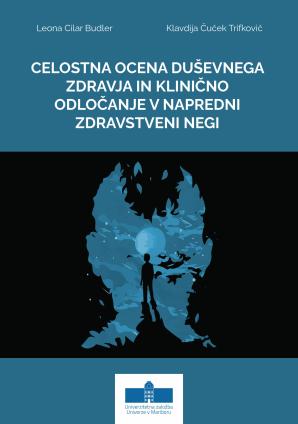Celostna ocena duševnega zdravja in klinično odločanje v napredni zdravstveni negi
Ključne besede:
duševno zdravje, celostna ocena, klinično odločanje, napredna zdravstvena nega, interdisciplinarni pristopKratka vsebina
Publikacija Celostna ocena duševnega zdravja in klinično odločanje v napredni zdravstveni negi obravnava ključne vidike ocenjevanja duševnega zdravja in proces kliničnega odločanja v zdravstveni negi. Poudarek je na uporabi strukturiranih metod, standardiziranih orodij in interdisciplinarnega pristopa pri obravnavi pacientov z duševnimi težavami. Obravnava specifične skupine, vključno z otroki, mladostniki in ranljivimi populacijami, ter ponuja smernice za napredno zdravstveno nego. Cilj publikacije je izboljšati kompetence zdravstvenih delavcev pri prepoznavanju, ocenjevanju in intervenciji v duševnem zdravju ter podpreti proces kliničnega odločanja. Publikacija je namenjena strokovnjakom v zdravstveni negi, ki želijo poglobiti svoje znanje in razviti celostni pristop k duševnemu zdravju pacientov.
Prenosi
Literatura
American Psychiatric Association, 2013. Diagnostic and statistical manual of mental disorders. 5th ed. Washington, DC: American Psychiatric Publishing.
Bar-On, R. & Parker, J. D. A., 2000. Emotional quotient inventory: youth version (EQ-i:YV): technical manual. Toronto, Canada: Multi-Health Systems.
Beck, A. T. et al., 1974a. The measurement of pessimism: the hopelessness scale. Journal of Consulting and Clinical Psychology, 42(6), pp. 861–865.
Beck, A. T., Schuyler, D. & Herman, I., 1974b. Development of suicidal intent scales. In: A. T. Beck, H. L. P. Resnik & D. J. Lettieri, eds. The Prediction of Suicide. Bowie, MD: Charles Press, pp. 45–56.
Beck, A. T. & Steer, R. A., 1990. BAI: Beck anxiety inventory. San Antonio: Psychological Corporation.
Beck, A. T., Steer, R. A. & Brown, G. K., 1996. Beck depression inventory-II. San Antonio: Psychological Corporation.
Beck, A. T. et al., 1978. Beck Depression inventory (BDI). San Antonio, TX: Psychological Corporation.
Bender, L., 1946. Bender-gestalt test. American Orthopsychiatric Association.
Boer, D. P., Hart, S. D., Kropp, P. R. & Webster, C. D., 1997. Manual for the sexual violence risk-20: professional guidelines for assessing risk of sexual violence. Vancouver, Canada: The British Columbia Institute Against Family Violence.
Brickenkamp, R., 1981. Test d2. Aufmerksamkeits belastungs-test.
Butcher, J. N. et al., 1989. manual for the restandardized minnesota multiphasic personality inventory: MMPI-2. Minneapolis: University of Minnesota Press.
Butcher, J. N., Graham, J. R., Williams, C. L. & Ben-Porath, Y. S., 1990. Development and use of the MMPI-2 content scales. Minneapolis: University of Minnesota Press.
Carniaux Moran, C., 2008. The psychiatric nursing assessment. Psychiatric mental health nursing: an introduction to theory and practice, pp. 41–43.
Delis, D. C., Kramer, J. H., Kaplan, E. & Ober, B. A., 2017. California verbal learning test–3. 3rd ed. San Antonio, TX: The Psychological Corporation.
Delis, D. C., Kaplan, E. & Kramer, J. H., 2001. Delis-Kaplan executive function system. The Psychological Corporation.
DiGiuseppe, R. & Tafrate, R. C., 2004. Anger disorders scale (ADS): technical manual. Toronto, Canada: Multi-Health Systems.
DiGiuseppe, R. & Tafrate, R. C., 2011. Anger regulation and expression scale (ARES): professional manual. Toronto, Canada: Multi-Health Systems.
Fahrenberg, J., Hampel, R. & Selg, H., 2001. FPI-R. Das Freiburger Persönlichkeitsinventar, 7.
Folstein, M. F., Folstein, S. E. & McHugh, P. R., 1975. “Mini-mental state”: a practical method for grading the cognitive state of patients for the clinician. Journal of Psychiatric Research, 12(3), pp. 189–198.
Garner, D. M., Olmsted, M. P., Bohr, Y. & Garfinkel, P. E., 1982. The eating attitudes test: psychometric features and clinical correlates. Psychological Medicine, 12(4), pp. 871–878.
Grant, D. A. & Berg, E., 1948. A behavioral analysis of degree of reinforcement and ease of shifting to new responses in a Weigl-type card-sorting problem. Journal of Experimental Psychology, 38(4), pp. 404.
Harris, G. T., Rice, M. E. & Quinsey, V. L., 1993. Violent recidivism of mentally disordered offenders: the development of a statistical prediction instrument. Criminal Justice and Behavior, 20(4), pp. 315–335.
Hathaway, S. R. & McKinley, J. C., 1984. Minnesota multiphasic personality inventory. Test Critiques, 1, p. 466.
Heuchert, J. P. & McNair, D. M., 2012. Profile of mood states, second edition (POMS 2): professional manual. Toronto, Canada: Multi-Health Systems.
Hoy, W. K., Tarter, C. J. & Woolfolk Hoy, A., 2006. Academic optimism of schools: a force for student achievement. American Educational Research Journal, 43(3), pp. 425–446.
Huebner, E. S., 1991. Initial development of the student's life satisfaction scale. School Psychology International, 12(3), pp. 231–240.
Kamphaus, R. W. & Reynolds, C. R., 2007. behavior assessment system for children, second edition (BASC-2) behavioral and emotional screening system (BESS). Circle Pines, MN: Pearson Assessments.
Knight, J. R. et al., 1999. A new brief screen for adolescent substance abuse. Archives of Pediatrics & Adolescent Medicine, 153(6), pp. 591–596.
Koch, K., 1949. Der Baumtest. Der Baumzeichenversuch als psichodiagnostiches Hilfsmittel.
Lane, K. L., Menzies, H. M., Oakes, W. P. & Kalberg, J. R., 2012. Systematic screening for behavior disorders. 2nd ed. New York: Guilford Press.
LeBuffe, P. A., Shapiro, V. B. & Naglieri, J. A., 2009. Devereux student strengths assessment (DESSA): manual. Villanova, PA: Devereux Center for Resilient Children.
Mathuranath, P. S. et al., 2000. A brief cognitive test battery to differentiate Alzheimer's disease and frontotemporal dementia. Neurology, 55(11), pp. 1613–1620.
Millon, T., 1983. Millon clinical multiaxial inventory (MCMI). National Computer Systems, Incorporated.
Moos, R., 1993. Life stressors and social resources inventory: coping responses inventory. Palo Alto, CA: Center for Health Care Evaluation, Department of Psychiatry and Behavioral Sciences, Stanford University.
Morey, L. C., 2004. the personality assessment inventory (PAI). Mahwah, NJ: Lawrence Erlbaum Associates Publishers.
Nolan, P., 2000. A history of mental health nursing. Cheltenham: Nelson Thornes.
Prince-Embury, S., 2007. Resiliency scales for children and adolescents: a profile of personal strengths. San Antonio, TX: Pearson.
Randolph, C., 1998. Repeatable battery for the assessment of neuropsychological status (RBANS). San Antonio, TX: Psychological Corporation.
Raven, J. C., 1936. Mental tests used in genetic studies: the performances of related individuals in tests mainly educative and mainly reproductive. Unpublished master's thesis, University of London.
Remes, O., Mendes, J. F. & Templeton, P., 2021. Biological, psychological, and social determinants of depression: a review of recent literature. Brain Sciences, 11(12), p. 1633.
Rey, A., 1941. L’examen psychologique dans le cas d’encéphalopathie traumatique. Archives de Psychologie, 28(112), pp. 286–340.
Rimland, B. & Edelson, S. M., 1999. Autism treatment evaluation checklist (ATEC). San Diego, CA: Autism Research Institute.
Rorschach, H., 1942. Psychodiagnostics. New York: Grune and Stratton.
Roth, R. M., Isquith, P. K. & Gioia, G. A., 2005. Behavior rating inventory of executive function®--adult version. Archives of Clinical Neuropsychology.
Shallice, T., 1982. Specific impairments of planning. Philosophical Transactions of the Royal Society of London, Biology, 298, pp. 199–209.
Skinner, H. A., Steinhauer, P. D. & Santa-Barbara, J., 1995. Family assessment measure (FAM-III): manual for administration, scoring and interpretation. Toronto, Canada: Multi-Health Systems.
Snyderman, D. & Rovner, B., 2009. Mental status examination in primary care: a review. American Family Physician, 80(8), pp. 809–814.
Stern, R. A. & White, T., 2003. Neuropsychological assessment battery. Lutz, FL: Psychological Assessment Resources.
Stroop, J. R., 1935. Studies of interference in serial verbal reactions. Journal of Experimental Psychology, 18, pp. 643–662.
Tonkonogy, J., 1997. brief neuropsychological cognitive examination (BNCE). WPS.
U.S. Department of Education, National Center for Education Statistics, 2016. ED School climate surveys (EDSCLS) user guide. Washington, DC: U.S. Department of Education. [Online] Available at: https://nces.ed.gov/surveys/edscls/ [Accessed 10. 01. 2025].
Walker, H. M. & Severson, H. H., 1992. Systematic screening for behavior disorders (SSBD) User’s Guide. Longmont, CO: Sopris West.
Webster, C. D., Douglas, K. S., Eaves, D. & Hart, S. D., 1997. HCR-20: assessing risk for violence (Version 2). Burnaby, Canada: Mental Health, Law, and Policy Institute, Simon Fraser University.
World Health Organization, 2022. Mental health. [Online] Available at: https://www.who.int/news-room/fact-sheets/detail/mental-health-strengthening-our-response [Accessed 10. 01. 2025].
Wechsler, D., 1997. Wechsler adult intelligence scale. Frontiers in Psychology.
Wright, K. M. & McKeown, M., 2018. Essentials of mental health nursing. London: SAGE Publications.
Zimmermann, P. & Fimm, B., 1994. Tests d’évaluation de l'attention (TEA)–version 1.02, manuel d'utilisation. Würselen, Germany: Psytest.
Zullig, K. J. et al., 2010. School climate: historical review, instrument development, and school assessment. Journal of Psychoeducational Assessment, 28(2), pp. 139–152.






